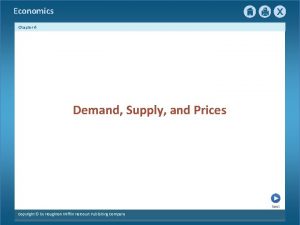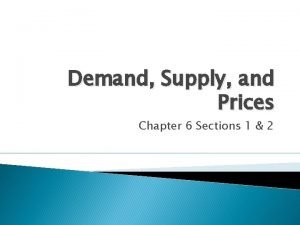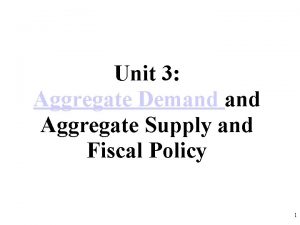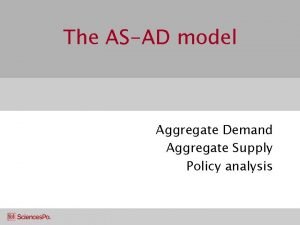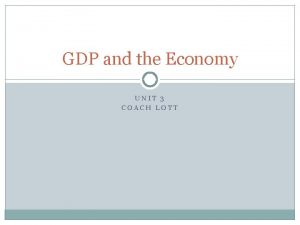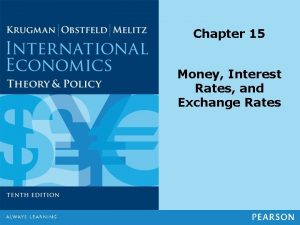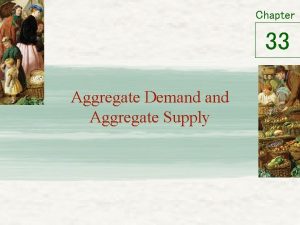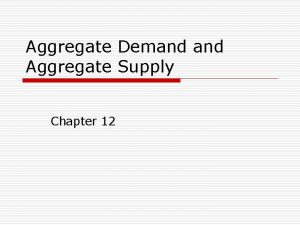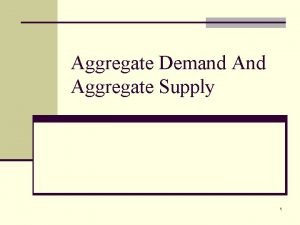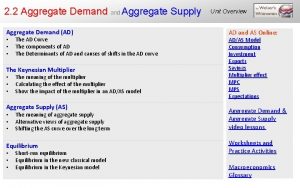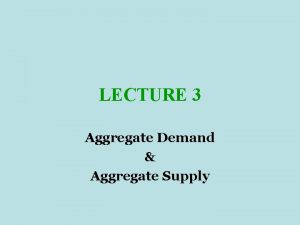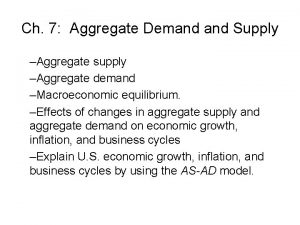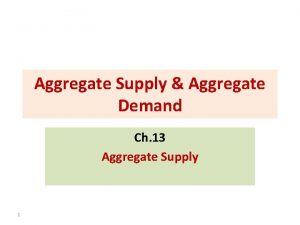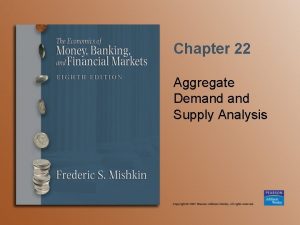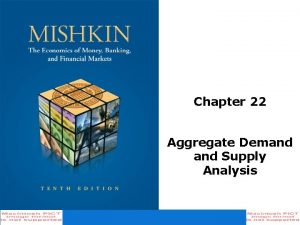Chapter 8 Aggregate Demand Aggregate Supply Online Texts























- Slides: 23

Chapter 8 Aggregate Demand Aggregate Supply © Online. Texts. com p. 1

The Circular Flow Diagram The circular flow diagram shows the flows of production and aggregate demand in the economy. © Online. Texts. com p. 2

Aggregate Demand • Aggregate Demand (AD) is composed of the sum of Consumption (C), Investment (I), Government Expenditures (G) and net exports (NX). AD = C + I + G + NX © Online. Texts. com p. 3

Investment vs. Saving • The terms “saving” and “investment” are often used interchangeably in common usage, but they have very different meanings in economics. • Saving (S) is disposable income not consumed. It is not a component of Aggregate Demand. In contrast, Investment (I) expands the productive capacity of the economy. © Online. Texts. com p. 4

The Aggregate Demand Curve and its Slope • The AD curve is downwardsloping because of the wealth effect and the international trade effect. © Online. Texts. com p. 5

The Wealth Effect • The wealth effect is a situation in which a price level increase reduces the purchasing power of financial assets, which leads to a reduction in a person’s wealth and, hence, consumption. © Online. Texts. com p. 6

The International Trade Effect • The international trade effect occurs when, for a fixed nominal exchange rate, an increase in the domestic price level leads to an appreciation of the domestic currency, which reduces net exports. © Online. Texts. com p. 7

Movements Along the Aggregate Demand Curve • Any factor that changes the price level leads to a movement along the AD curve. © Online. Texts. com p. 8

Shift of the Aggregate Demand Curve • A change in any factor other than a change in the price level that changes the level of Aggregate Demand results in a shift of the Aggregate Demand curve. © Online. Texts. com p. 9

Factors that Shift the AD Curve • Factors that shift the AD curve include: – A change in consumption (perhaps due to a change in income taxes) – A change in investment – A change in government expenditures – A change in net exports (perhaps induced by a change in exchange rates or foreign incomes) © Online. Texts. com p. 10

Aggregate Supply The Aggregate Supply curve graphs the total amount of output (Y) produced at various price levels. The curve slopes upward in the short run because input costs are assumed fixed. © Online. Texts. com p. 11

Long-run Aggregate Supply The long run is a period of time in which all prices and costs are variable. An increase in the price level will have no impact on long-run Aggregate Supply because all firms' costs will rise proportionately with the price level. © Online. Texts. com p. 12

Movements Along the Short-Run Aggregate Supply curve • When the price level changes but resource costs are held constant, there is a movement along the Aggregate Supply curve © Online. Texts. com p. 13

Shifts of the Short-Run Aggregate Supply curve • A change in any factor other than a change in the price level that changes the level of Aggregate Supply shifts the Aggregate Supply curve. © Online. Texts. com p. 14

Factors that shift the AS Curve • Three nonprice factors that shift the Aggregate Supply curve are – changes in resource costs: an increase (decrease) in resource costs shifts the AS curve to the left (right). – An advance in technology shifts the AS curve to the right. – An increase (decrease) in inflation expectations shifts the AS curve to the left (right). © Online. Texts. com p. 15

Short-Run Equilibrium • A short-run equilibrium occurs where the AD and AS curves intersect at point E. © Online. Texts. com p. 16

Long-Run Equilibrium The long-run equilibrium can only occur where the Aggregate Demand curve crosses the vertical Long Run Aggregate Supply curve because in the long run, equilibrium output must equal potential output. © Online. Texts. com p. 17

Disequilibrium: AD exceeds AS • If AD > AS, firms’ inventories unexpectedly deplete, leading firms to ramp up prices and production, helping to restore equilibrium. © Online. Texts. com p. 18

Disequilibrium: AS exceeds AD • If AS > AD, firms’ inventories unexpectedly accumulate, leading firms to reduce prices and production, helping to restore equilibrium. © Online. Texts. com p. 19

Aggregate Demand, Aggregate Supply, and the Business Cycle • “Typical" business cycles are generated by fluctuations in Aggregate Demand. © Online. Texts. com p. 20

Aggregate Demand, Aggregate Supply, and the Business Cycle • However, business cycles can also result from fluctuations in Aggregate Supply (e. g. oil shocks), which may lead to stagflation. © Online. Texts. com p. 21

Paradox of Thrift • The Paradox of Thrift states that an increase in the desire of the economy as a whole to save more may lead to a decrease in output and employment, thus thwarting the attempt to save more. • Is it good for the economy to save income or to consume? • The U. S. in the post-war era had much higher consumption rates (and lower saving rates) than in Japan, yet its economy grew more slowly. Why? © Online. Texts. com p. 22

Paradox of Thrift • The paradox of thrift assumes that investment does not increase with the increased saving, so AD shifts to the left. © Online. Texts. com p. 23
 Chapter 33 aggregate demand and aggregate supply
Chapter 33 aggregate demand and aggregate supply Aggregate demand and aggregate supply
Aggregate demand and aggregate supply Unit 3 aggregate demand and aggregate supply
Unit 3 aggregate demand and aggregate supply Unit 3 aggregate demand aggregate supply and fiscal policy
Unit 3 aggregate demand aggregate supply and fiscal policy Unit 3 aggregate demand aggregate supply and fiscal policy
Unit 3 aggregate demand aggregate supply and fiscal policy Aggregate of chapter 6
Aggregate of chapter 6 Aggregate supply shifters
Aggregate supply shifters Aggregate supply and demand graph
Aggregate supply and demand graph Planning techniques
Planning techniques Module 5 supply and demand introduction and demand
Module 5 supply and demand introduction and demand Matching supply with demand
Matching supply with demand How to mix aggregate and non aggregate tableau
How to mix aggregate and non aggregate tableau Shifters of supply
Shifters of supply Chapter 6 section 2 supply and demand in everyday life
Chapter 6 section 2 supply and demand in everyday life Chapter 6 demand supply and prices
Chapter 6 demand supply and prices Chapter 6 supply demand and government policies
Chapter 6 supply demand and government policies Chapter 5 section 1 supply and the law of supply
Chapter 5 section 1 supply and the law of supply Why is aggregate demand downward sloping
Why is aggregate demand downward sloping Sras lras
Sras lras Fisher's equation
Fisher's equation Aggregate demand curve
Aggregate demand curve Recessionary gap aggregate demand
Recessionary gap aggregate demand The aggregate real money demand schedule l(r,y)
The aggregate real money demand schedule l(r,y) The aggregate real money demand schedule l(r,y)
The aggregate real money demand schedule l(r,y)













